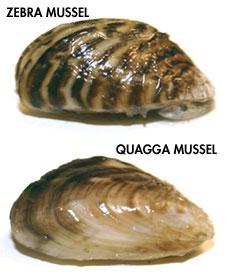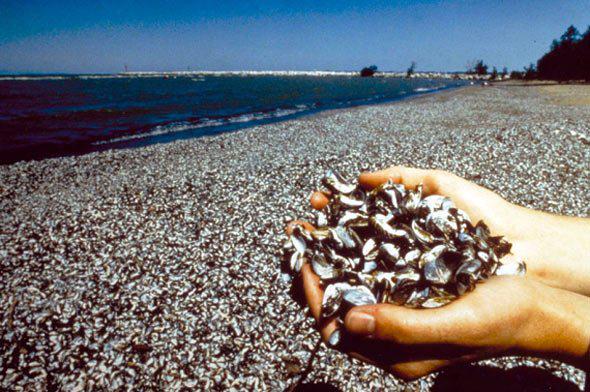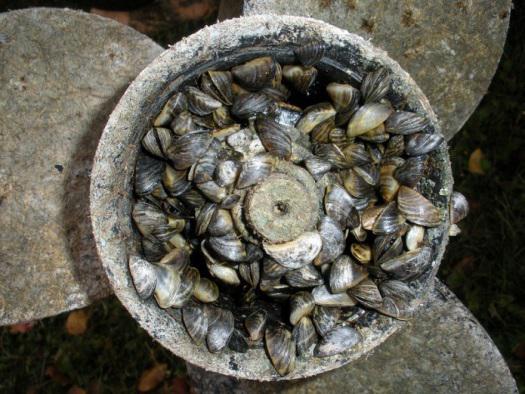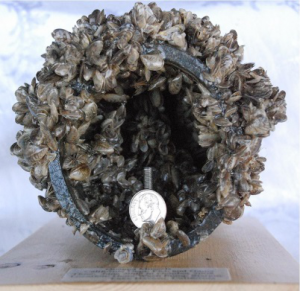Zebra and Quagga Mussels

Credit: U.S. Forest Service
Among the most damaging AIS that could appear in Whatcom County are the zebra and quagga mussels (Dreissena polymorpha and Dreissena bugensis).
These invasive mussels are native to Eurasia in the Black, Azov, and Caspian Sea drainages. They did not appear in North America until the mid-1980s when they were brought to the Great Lakes by large, transoceanic ships in ballast tanks or on anchor chains. These very small freshwater mussels have now wreaked havoc throughout much of the United States since their detection in the Great Lakes in the late 1980s.
What are they?
Zebra and quagga mussels are fingernail-sized freshwater mussels that range in size from 1/8 to 2 inches in length. Their shells are typically marked by alternating light- and dark-colored stripes and range in color from yellowish to darker brown in color. Unlike native North American mussels, these mussels are capable of attaching themselves to a large variety of substrates using byssal threads. This adaptation allows zebra and quagga mussels to spread easily to uninfested waterbodies by hitching a ride on boat hulls, motors, and recreational equipment.

Great Lakes Environmental Research Lab
Are they here yet?
In 2023, quagga mussel larvae were discovered in the Snake River in Twin Falls, Idaho. Idaho is implementing a response plan which entails closing multiple boat launches, sampling, containment and evaluating potential treatment options.
Other western states with quagga or zebra mussels documented include California, New Mexico, Arizona, Nevada, Colorado, and Utah. These may seem really far away, but adult mussels can live out of the water for up to 30 days when the air temperature and humidity are ideal. In July, an adult mussel might be expected to survive out of water in northwest Washington for an average of 12 days, depending on the weather conditions. That’s plenty of time to drive over to Lake Whatcom!

Photo by Flickr User Townepost Network
Why should you care?
A female mussel is able to produce up to one million offspring per spawning season and while they grow, they attach very tightly to hard surfaces causing damage to water intakes, filtration equipment, boat hulls and motors, and other personal property. Mussel densities of well over 100,000 per square meter have been observed in several waterbodies, resulting in billions of dollars in damages and estimated annual control costs of at least $1 billion nationwide.

Mussel Prevention Program, San Luis Obispo Co., Calif.
Potential Damage
If these mussels were to become established in Whatcom County lakes, they could:
- Clog water intake structures restricting flows to drinking water supplies
- Increase water treatment costs
- Foul and damage dams, piers, docks and pilings
- Create long-term taste and odor issues in drinking water
- Cover beaches and swimming areas in sharp mussel shells
- Damage boats and equipment
- Decrease property values
While adult mussels are fairly visible and easier to spot, it is the immature form – veligers or larvae – which are virtually invisible in the water that pose the bigger detection problem. This is why it is very important to CLEAN, DRAIN, and DRY everything that has been in a lake to prevent the spread of these mussels.
Report Sightings: Call 1-877-9-INFEST or report online.
More Resources:





